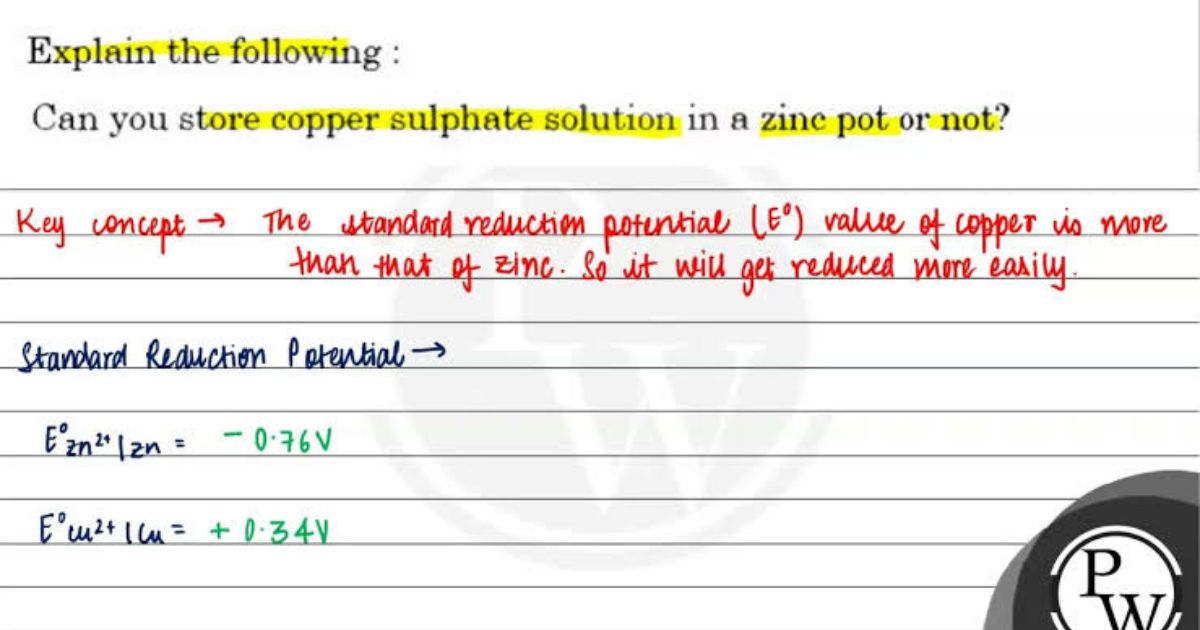
Introduction
When it comes to storing chemical solutions, understanding the reactivity between the container and its contents is crucial for safety and material preservation. A common question in chemistry is: Can you store copper sulphate solution in a zinc pot? In this article, we’ll examine the chemical interactions that occur between copper sulphate and zinc, discuss the implications of such storage, and explain why this practice is generally discouraged.
The Chemical Reaction Involved
Copper sulphate (CuSO₄) is a salt that, when dissolved in water, dissociates into copper ions (Cu²⁺) and sulphate ions (SO₄²⁻). Zinc, being a more reactive metal, can undergo a displacement reaction when it comes in contact with copper sulphate solution.
The Displacement Reaction
The relevant chemical reaction is:
\text{Zn (s)} + \text{CuSO}_4 \text{(aq)} \rightarrow \text{ZnSO}_4 \text{(aq)} + \text{Cu (s)}
- Zinc (Zn), being more electropositive, displaces copper (Cu) from the solution.
- Copper (Cu) precipitates out as a solid, often depositing as a reddish layer on the surface of the zinc pot.
- Zinc sulphate (ZnSO₄) forms in the solution.
This reaction is spontaneous and exothermic under normal conditions.
Implications of the Reaction
1. Corrosion of the Zinc Pot
- Material Degradation: As zinc reacts with copper sulphate, the pot itself will gradually corrode. The loss of zinc from the pot compromises its structural integrity and longevity.
- Formation of Copper Deposits: The copper precipitated on the pot’s surface not only tarnishes the appearance but also can interfere with the pot’s functionality over time.
2. Contamination of the Solution
- Altered Composition: The conversion of copper sulphate to zinc sulphate changes the chemical composition of the solution, which could be problematic if a specific concentration of copper ions is required for a process or experiment.
- Unintended Reactions: The presence of precipitated copper might further catalyze other chemical reactions or complicate the intended use of the solution.
Practical Considerations
- Alternative Containers: For storing copper sulphate solution, it is advisable to use containers made of non-reactive materials such as glass or certain plastics (e.g., polyethylene or polypropylene) that are chemically resistant.
- Safety First: When working with chemicals, always consult compatibility charts or material safety data sheets (MSDS) to ensure that the storage container is suitable for the chemical in question.
Conclusion
Storing copper sulphate solution in a zinc pot is not recommended due to the displacement reaction that occurs between zinc and copper sulphate. This reaction leads to the corrosion of the zinc pot, deposition of copper on the pot’s surface, and a change in the composition of the solution—all of which are undesirable in most practical scenarios.
By choosing an appropriate, non-reactive container, you can ensure both the integrity of your storage vessel and the stability of your chemical solution.
Disclaimer: This article is for informational purposes only and does not substitute professional advice. Always consult chemical compatibility resources and safety guidelines when handling and storing chemicals.
Also Check:
• How Much Copper Can Be Obtained From 100g of CuSO₄? A Detailed Calculation
• How Neha Can Determine That a Chemical Reaction Has Happened
• Which of the Following Can Be Beaten into Thin Sheets? Understanding Malleability in Metals
• Can the Process of Rusting Be Called Combustion? A Detailed Discussion



